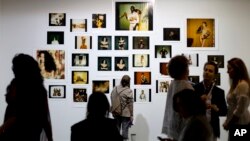ArtRio looked poised to join the ranks of the world's most elite art fairs when it burst onto the scene five years ago and Brazil's booming economy was bursting with would-be collectors. But with the South American giant now mired in recession and pessimism about the future widespread, the fifth edition of Rio de Janeiro's showcase art fair is a pared-down and more modest affair.
After four years of near-continual expansion, this year's fair — which opened to the public on Thursday — is about 20 percent smaller than the last. In 2014, 99 top galleries from Brazil and beyond were present, compared with just 80 this year. That's roughly the same number as were present at the first edition in 2011.
Some of the heaviest hitters, including New York's Gagosian Gallery, haven't made the trip, reportedly over concerns about the Brazilian economy and stormy political landscape.
President Dilma Rousseff has seen her popularity ratings fall to the single digits amid a snowballing corruption scandal at Brazil's largest company, state-run oil giant Petrobras. Rousseff has denied any knowledge of the scheme, but several politicians in her inner circle have been caught up in the probe, leading to speculation the government could fall.
Amid the turmoil, the Standard & Poor's rating agency on Wednesday stripped Brazil of its investment-grade credit rating, making a swift recovery appear even less likely.
Making matters worse for art lovers is the vertiginous plunge of the local currency. The Brazilian real has lost more than 30 percent of its value against the dollar over the past year, pushing the prices of top-tier pieces into the stratosphere.
Some gallerists and visitors at the fair, which is held in sprawling warehouses in downtown Rio's once-derelict port region, said they feared a prolonged crisis could spell the end of ArtRio.
But the fair's co-founder and director, Brenda Valansi, brushed aside worries about the long-term future and said she hoped sales at this year's fair would remain more or less stable.
"Good pieces will always be bought,'' she said.
Fabiane Del Nero, manager of Sao Paulo's Marilia Razuk Gallery, wasn't so sure.
"I have the impression that people are pretty hesitant,'' Del Nero said at the gallery's stand at the fair. "People are no longer impulse-buying art as they had in recent years. Now, they have a second, a third and a fourth thought before going ahead.''
Laura Marsiaj of the Rio-based Marsiaj Tempo Gallery, which specializes in contemporary art and photography, said her gallery has had to absorb much of the impact of the weakening Brazilian real in order keep her mostly collector customers buying. The gallery has set a fixed rate for pieces priced in dollars that's much lower than the real exchange rate.
She worried that a prolonged financial crisis could prove fatal for ArtRio.
The absence of such powerhouses as Milan's Cardi Gallery and Gagosian, which has more than a dozen branches in seven countries, bodes poorly for the fair's lesser-known gallerists: Fewer top collectors make the trip, resulting in plunging sales for everyone, she said.
Still, fairgoer Carlos Bertao saw a silver lining in Brazil's financial turmoil.
"I see the crisis as a two-sided coin,'' said Bertao, a retired World Bank employee and Rio resident. "On one side, for the foreign artists, the pieces are very expensive for us because the dollar that was being exchanged at ArtRio last year for around 2.50 reais [and] today it's like 3.80 reais. So that means that everything in foreign currency is really unreachable for regular middle-class Brazilians. But at the same time it is a window of opportunity for the Brazilian artists because they kept their prices in reais.''
ArtRio director Valansi agreed.
"Today we see Brazilian artists at the MoMA and other places,'' she said, referring to New York's Museum of Modern Art. "International art collectors are on the lookout for Brazilian art like never before.''
ArtRio runs through Sunday at Rio's Pier Maua.




